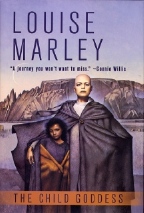The Child Goddess
Louise Marley
ACE / Penguin-Putnam
US Hardcover First
ISBN 0-441-01136-5
Publication Date: May 2004
Pages; Price: 324; $23.95
Date Reviewed: 28-04-04
Reviewed by: Katie Dean © 2004

REFERENCES
COLUMNS
|
|
|
The Child GoddessLouise MarleyACE / Penguin-PutnamUS Hardcover FirstISBN 0-441-01136-5Publication Date: May 2004Pages; Price: 324; $23.95Date Reviewed: 28-04-04Reviewed by: Katie Dean © 2004 |
|
|
REFERENCES |
COLUMNS |
'The Child Goddess' is an engaging story that one cannot help feeling compelled to read. Louise Marley writes in an easy-going style and has a true gift for story telling. She also aims to deal with some hard issues. In this, Marley succeeds in provoking some thought, but does little to really explore the issues with which she is concerned and certainly does not shed any new light on them. However, this does nothing to detract from the success of this novel; it is science fiction at its most appealing - light on the science and heavy on the fiction.
The action takes place around three to four hundred years from today. Marley focuses on a handful of characters and tells the story of a child removed from her own distant planet and brought to earth for the purposes of scientific research. The main character, Isabel Burke is a Catholic priest of the newly established female order of the Mary Magdalenes. She is brought in to act as guardian of the child and thus legitimise the research program. However, she is genuinely concerned for the child's welfare and makes every effort to put that before the quest for knowledge. The story unfolds with plenty of action. Marley's style is rather like that of a soap opera, offering short scenes usually ending in suspense before switching to another scene with different characters. It is this style that is in large part responsible for creating such a compelling read. Marley is masterful in the control she exercises over the story as it unfolds.
Even this paltry outline of the scenario indicates the number of issues with which 'The Child Goddess' is concerned. Louise Marley herself proclaims to find the Biblical character, Mary Magdalene, very intriguing. For centuries she has been condemned as a common whore. However, she can also be seen as the first female disciple. As Marley points out, discussion of the correct interpretation of Mary Magdalene is rife. Marley herself prefers to see Mary as a disciple figure and it is this that inspired her to create the female Catholic order to which her heroine belongs. Unfortunately, Marley goes no deeper than this. Without reading her author's note one would be quite unaware of the deeper significance of the religious order at the center of this novel. This is a shame as Marley is quite right, the question of Mary Magdalene's identity provides more than ample material for a novel. In this instance this material is largely ignored and Marley makes no contribution to the wider debate about Mary.
A similar comment can be made about Marley's treatment of the major theme in her story, the question of scientific ethics. Highly topical, 'The Child Goddess' is really asking about the extent to which human rights or moral ethics can and should be sacrificed in the interests of developing our knowledge. Is it acceptable to infringe upon the quality of life of a single member of a sub species in order to benefit the entire human race? Do scientists spend too little time considering the wider implications of a single revolutionary discovery? These are the questions that Marley is asking the reader to consider. These questions are of course highly relevant to much of the science of today; genetically modified crops and cloning are two issues that immediately spring to mind. Marley deals with them in an adequate fashion and creates a compelling story to illustrate her point, but she offers nothing particularly new or insightful.
'The Child Goddess' offers a very interesting view of the world several centuries from now. Being set so far in the future, one might expect to find an unrecognizable world. In fact Marley's setting is one of the great successes of the novel. She resists the temptation to step into the fantastical, even improbable. Her vision of Earth is very recognizable as the Earth of today. Clearly technological advances have been made, but there remain physical and cultural remnants of today's society. Today we are still able to admire some architecture dating back three or four centuries or more. We can also trace our religious and social practices back that far and further, so it seems natural to assume that the same will be true four hundred years from now. This makes for a much more realistic setting than many science fiction novels offer, hence the suggestion that 'The Child Goddess' focuses primarily upon the fiction and only incidentally upon the science.
Despite the failure to address in any depth the important issues with which 'The Child Goddess' is concerned, this novel is well written, compelling and definitely worth reading.